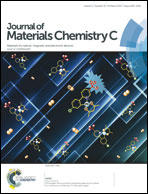Optical properties of SiO2@M (M = Au, Pd, Pt) core–shell nanoparticles: material dependence and damping mechanisms†
Abstract
Optical properties of SiO2@Pd and SiO2@Pt core–shell nanoparticles (NPs) are investigated experimentally and theoretically, combined with a systematic comparison with those of traditionally investigated SiO2@Au NPs. Theoretical calculations show that both the plasmon hybridization effect and the retardation effect influence the spectral peak position of all three kinds of core–shell NPs. These two effects compete with each other. Plasmon hybridization is a dominant influence in the case of a thinner shell, whereas the retardation effect becomes more important when the shell becomes thicker. As a result, the dipolar plasmon band reveals an initial blue shift, and then red shift, with the increase of shell thickness. Furthermore, the influences of core size and shell material on the competition are discussed. Finally, the relative strengths of absorption and scattering associated with the LSPR of the three kinds of core–shell NPs are investigated. For SiO2@Pd and SiO2@Pt NPs, extinction is found to be dominated by absorption when shell thickness is less than ∼20 nm, and a crossover from absorption dominance to scattering dominance takes place with the further increase of shell thickness. In contrast, scattering is always the main decay process for SiO2@Au NPs, which contribute more than 90% intensity of the extinction despite the shell thickness.


 Please wait while we load your content...
Please wait while we load your content...